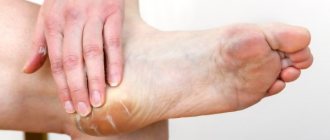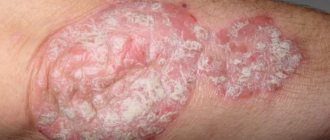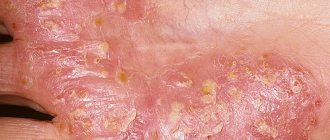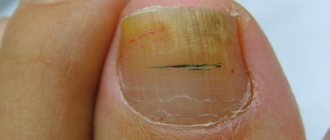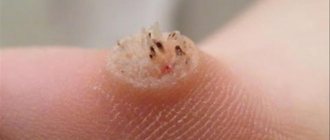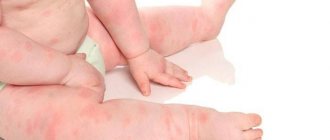Unfortunately, quite often the nails “get sick”, which is why they become unattractive. And almost the most common disease is nail psoriasis, or as it is also called, psoriatic onychodystrophy. This variety is considered a serious skin disease even in the initial stages. Doctors and scientists describe it as a type of chronic disease that is not infectious, but (in the absence of proper treatment) involves further progression of the disease throughout the skin areas of the entire body.
Symptoms and signs of the disease
It is worth saying that this disease has several types, respectively, the symptoms of nail psoriasis vary, but there is a certain number of signs that can help you find out how to identify nail psoriasis. Namely:
- pits on the nails of various shapes and sizes, folds;
- coloring of the plate that is unusual for a healthy nail (shades of gray, brown, yellow);
- dull plate color;
- thinness, fragility, easy damage;
- reddish inflamed skin around, peeling;
- peeling of the nail plate;
- various spots on the fingernails and toenails;
- visibility of capillaries through the nail;
- abscess under the nails;
- frequent itching in the area of the fingers, possibly a burning sensation.
It should also be noted that nail psoriasis can exist both as a separate form of the disease and as part of it, so it is necessary to carefully monitor the condition of your skin during the incubation period in order to prevent large-scale damage.
Types of nail psoriasis
As already mentioned, onychodystrophy can have different types. It is very important to know the differences between them, since not only the symptoms differ, but also the treatment of nails. So, there are the following types of nail psoriasis:
- Thimble symptom
- Trachyonychia
- Nail onycholysis
- Onychomodesis
- Subungual hemorrhages
- Psoriatic paronychia
To know for sure what the difference is between the above forms of the disease, what specific type you have, how to cure nail psoriasis and what signs may indicate the reason for an immediate visit to the doctor, we will analyze each form separately.
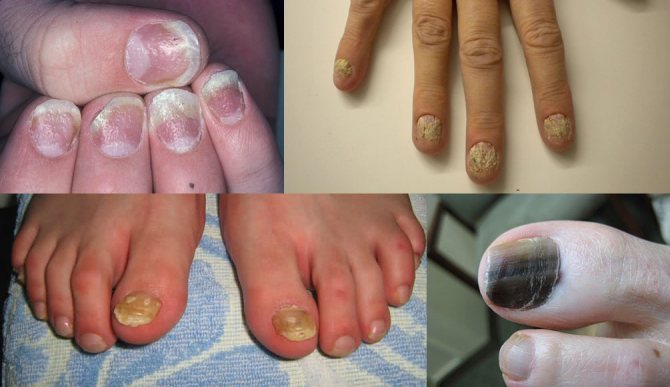
Thimble psoriasis
Psoriasis on the nails is becoming increasingly common among people of different ages and social categories; its most common form is the thimble symptom. And it got this name for a reason. The fact is that the surface of the nail plate in this case really resembles a thimble. A distinctive feature of the thimble on the nails is the presence of pits, the diameter of which can reach 2 mm. It is believed that the cause of dimpled fingernails is improper development. In this case, the lack of microelements in the composition of the nail is a consequence of nail dystrophy. The dimples formed as a result of this problem can be located anywhere and have different sizes. Also, completely healthy people can “boast” of these pits if they have no more than 2-3 such points on one nail plate, and when a new nail grows, such deviations are not observed.
Trachyonychial form
This type is more common on toenails than on fingernails, but is nonetheless common in both. It differs from the others in that the characteristic of this type is a rough surface, that is, there are no depressions, but the structure itself is uneven. In addition, very often the color of the plate becomes dull with this type of disease. This form also has its own subspecies, which is called colonychia. This is a kind of hole on the nail, due to which, subsequently, it can acquire a concave shape.
Onycholysis
Another fairly common form. You can suspect it when your nails begin to peel. It is worth saying that the nail plate peels off gradually, and not immediately. There are also subtypes of onycholysis itself, depending on the scale of the lesion and the direction in which the layer peels off (detachment occurs):
- full or partial;
- central, lateral or distal;
In this form of the disease, a change in the color of the surrounding skin (yellow or pink) is also observed. Also, this type of disease is characterized by changes in the color of the nail plate from gray to dark brown. Psoriasis of the toenails and fingernails in this case may be accompanied by a strong and unpleasant odor, which indicates the probable presence of fungus on the nails, which could appear due to open surfaces through which various bacteria and viruses can easily pass. By the way, some people confuse these 2 diseases, which can accompany each other or develop separately.

DOCTORS RECOMMEND:
In order to get rid of psoriasis and restore the original health of the skin, use a proven method: apply a simple product for 7 days in a row...
more details >
Only a doctor knows in detail how to distinguish nail fungus from nail psoriasis. Because of this, treatment for onycholysis is quite difficult and long.
Onychomodesis
This form of nail disease is practically no different from the previous one, except that the nail plate in this case peels off quickly, and the border is completely absent.
You may be interested in: Seborrheic psoriasis: diagnosis and treatment methods
Subungual hemorrhages
Subungual psoriatic erythema is characterized by the appearance of dark spots on the nails, which, depending on the subtype, have their own color. That is, if a small capillary bursts inside the finger, a pink or red spot will be visible, if a larger one - a brown one.
Psoriatic paronychia
It is believed that this form cannot exist independently and appears only in the case of pustular psoriasis. Characteristic in this case is severe inflammation of the skin around the nail.
Symptoms of nail psoriasis
Despite the fact that nail psoriasis is considered an independent disease, sometimes it manifests itself as one of the forms of vulgar extensive psoriasis or portends its occurrence.
In approximately half of cases, psoriasis of the nails and skin is observed simultaneously.
Symptoms of nail psoriasis may vary depending on the affected area. Pathological changes in the root part (matrix) are reflected in the length, shape and, to some extent, the thickness of the nail plates, and the pathology of the bed (the connective layer that serves as the base of the plate) mainly affects the thickness. Taking these features into account, the disease can manifest itself in the following forms:
- Thimble-shaped, characterized by bending and clouding of the plate; at the same time it becomes like a hook. Grooves and pinpoint depressions appear on the stratum corneum, arranged in a chaotic manner. It is curious that the formations on different fingers differ in size, shape and color. Pressing on such a “thimble” causes pain;
- When the nail is distorted and damaged, accompanied by a change in its color and detachment from the base of the finger, we are dealing with the onycholysis form of psoriasis. This unpleasant picture is complemented by air bubbles and dirt that have penetrated under the peeling nails, mixed with dead epidermal particles;
- When, due to damage to the capillary vessels under the nails, bluish, brown or red translucent spots or stripes appear, and the plate itself becomes cloudy and changes appearance, they speak of psoriasis under the nails. In other words, dark spots on the nails with psoriasis are a sign of subungual hemorrhages. If force is applied to the diseased nail, pus may appear.
Of the many other, less common manifestations of the disease, we note trachyonychia - the nail becomes coarser, becomes rough and dull; paronychia - with painful infiltrates affecting the periungual ridges; onychogryphosis, in which the nail (mostly the thumb) becomes like a vulture's claw.
In addition to physical discomfort and a constant feeling of pain combined with itching, psoriasis on the toenails, and especially psoriasis on the fingernails, which is more conspicuous, causes the patient a lot of psychological suffering and negative emotions due to the unaesthetic appearance of their own limbs. This is what makes millions of people on Earth think: how to cure psoriasis? How to return your nails to their original appearance?
Stages of psoriasis on the nails
Treatment of nail psoriasis and restorative therapy depend not only on the form, but also on the neglect of the case, in other words, the stage of the disease. There are three of them in total, each of which has its own characteristics.
- The first stage is characterized by a change in shade. As a rule, it darkens, and various depressions also form, the shape of which depends on the type of disease.
- Second stage. The nail plate thickens and the color changes. In the case of subungual hemorrhages, spots appear, and pus may also be discharged.
- Third stage, extreme. At this moment, the nail itself or its layer peels off. Sometimes it is accompanied by infections, most often fungal, getting into open wounds.
It is very important to consult a specialist at the first stage of the disease, then treatment will be quick and most effective and painless.
Causes of nail psoriasis
It is believed that the main cause of psoriasis is, in principle, a decrease in immunity. Due to a malfunction, the body begins to actively produce certain substances, which leads to thickening of the epithelium, causing the nail plate on the hands and feet to suffer. The body, in turn, does not perceive this and starts the inflammatory process. Heredity can also be considered the cause of psoriasis on the nails. But it is worth remembering that a malfunction in the body is provoked by certain actions, avoiding which, you can protect yourself from the occurrence of psoriasis on the nails. These are the following factors:
- unfavorable conditions (when it becomes cold and dry outside, the risk of decreased immunity to various viral diseases that can lead to psoriasis increases);
- chronic depression, stress;
- various mechanical injuries of the epithelium;
Interestingly, most often young people under 20 or old people are at risk. This disease can also be found in children, but still much less frequently.
Splitting in the middle of the nail can occur due to manicure
Author Alexandra Balan-Senchuk
Updated: 10/23/2019 14:44 Published: 09/20/2019 21:10
Health
Median nail dystrophy refers to a longitudinal splitting in the middle of the nail. The split starts from the cuticle at the base of the nail and continues to grow outward to the edge.
0 shared
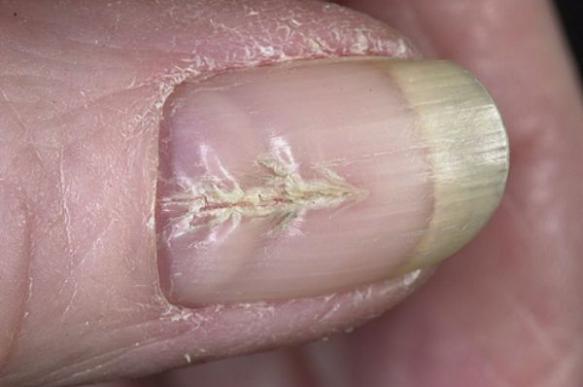
In medical terminology, which disease is also known as medial tubular nail dystrophy or Heller's median tubular dystrophy, named after the man who recorded the first known case of the disorder in 1928.
What is median nail dystrophy?
This is a condition that affects the nail bed of the big toe, although in rare cases it can be found on other nails. A symmetrical defect flows along the nail plate, leading to longitudinal splitting of the nail. The splitting begins at the base of the big toe near the cuticle. Along with a longitudinal cut in the nail there is a series of horizontal grooves. These side splits are responsible for the characteristic upside-down spruce look on the nail. The lunula often enlarges as a result of pressure from the base of the nail.
Causes of median nail dystrophy
A temporary defect in the nail matrix is the main cause of this disorder. This can be caused by sudden, sharp trauma to the nail or even repeated self-inflicted trauma. Pulling back the cuticle during a manicure can also damage the nail plate and cause moderate nail dystrophy.
Median nail dystrophy can also develop as a reaction to certain medications. Reported cases include the disorder occurring when isotretinoin was used to treat acne, or alitretinoin was prescribed for chronic eczema. Other retinoic acid medications may also cause similar nail damage.
Habitual nail deformation
Sometimes the condition can be confused with a habitual deformity that occurs due to habitual plucking in the area of the proximal bend of the nail. This is often done by patients with mental illnesses such as obsessive-compulsive disorder, depression and impulse control disorder. However, habitual deformity is not the same as median nail dystrophy. Patients with mental illness need to behave differently than patients with moderate nail dystrophy. The psychiatrist may need to do a complete assessment of the patient before prescribing medications and behavioral counseling.
Treatment of moderate nail dystrophy
The prognosis for moderate nail dystrophy caused by physical trauma is usually quite good. Although the pathogenesis of the disease is unknown, treatment is highly effective. A combination of a topical ointment such as Tazaotene 0.05% applied to the nails at night along with a daily dose of a multivitamin can cure the condition.
If medial nail dystrophy is associated with the consumption of retinoid-based medications, it should be discontinued. Ideally, stopping the medication is enough for the nails to recover. If the nail does not heal even after stopping the drug for several months, it is recommended to consult a dermatologist to determine further steps.
In addition, it is recommended to shorten the length of the nail and polish the surface of the nail to prevent the edges from catching on clothing and causing damage. A few months after the start of treatment, nail plate abnormalities will begin to clear up.
Photo: znatprovse.ru
Diagnostics
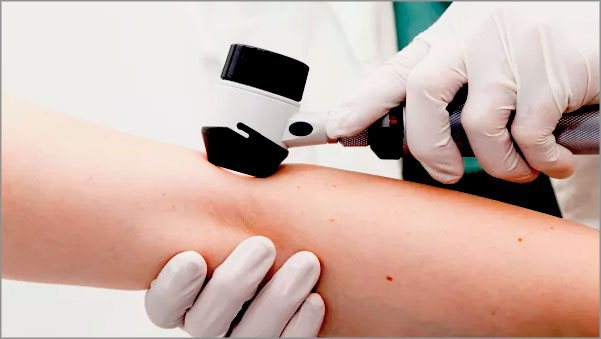
If you consult a doctor in the initial stages of the development of the disease, then the diagnosis of the disease will be only external, that is, doctors will be able to determine the form with the help of an ordinary examination. If the case is more advanced, then a biopsy of the affected area of skin, separated from under the nail or its compaction, is often performed.
In the case of this analysis, the diagnosis is clarified and verified. It is compared with various skin diseases, which may be caused by infections. And after that they determine how to treat nail psoriasis or fungus, and possibly another skin disease that was identified through analysis.
Possible complications
Erythema as a symptom of dermatological problems
It is believed that it is completely impossible to cure nail psoriasis. With the help of complex therapy, the disease is transferred to the latent phase until the next relapse. That is, the symptoms are less disturbing, but at the slightest provocation they worsen. In addition to the undulating course and not an optimistic prognosis, the disease is complicated by disturbances in other organs and systems.
If nail psoriasis is not treated, or if it is done unsteadily, the following dangerous consequences are inevitable:
- atherosclerosis;
- inflammation of the heart muscle and lining of the heart (myocarditis and pericarditis);
- heart attack
The cardiovascular system is most often affected. In addition, hormonal imbalances and the development of diabetes are possible.
Since the treatment of pathology is an almost permanent process, patience and psychological stability are required from the patient. Many patients, during therapy, have emotional breakdowns, which provokes a new round of the disease.
As for the common belief that skin or nail psoriasis can cause cancer, this is a myth. Oncology can occur, but not as a consequence of psoriatic changes, but as a separate disease.
How to treat nail psoriasis
Treatment of psoriasis of the fingernails and toenails is individual for each patient, so experts do not recommend getting rid of the problem at home on your own, especially in the case of the first manifestation of psoriasis, as it can harm the body and make the situation even more advanced. Only a doctor can determine how to treat psoriasis on the nails. After the results of the necessary tests are ready, only he decides how to treat the disease.
In the initial stages, doctors usually prescribe various creams and ointments for psoriasis for topical use, which can not only get rid of psoriasis, but also destroy fungal bacteria, which sometimes provoke relapses. Popular ones are Triacort, Triamcinolone, Daivonex and prednisolone ointment.
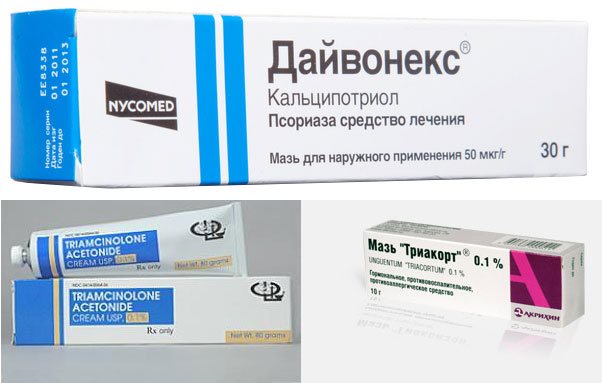
Creams such as Anthralin, Micanol and Dithranol are also used, which slow down the process of division of affected cells.
Salicylic acid is especially popular for psoriasis. It has been known to us for its properties since childhood. In addition to the fact that the product removes the unpleasant symptoms of the disease and also enhances the effect of other medications, it is approved for use by children being treated. Only doctors recommend using salicylic ointment, rather than acid, for psoriasis in children, since it is more gentle. Also, salicylic ointment is more useful for psoriasis because it has additional components that restore damaged skin.
You may be interested in: Psoriatic arthritis - causes of joint damage in psoriasis
If local treatment does not help the patient, it is decided how to treat nail psoriasis using systemic therapy. The most commonly prescribed drugs are: Cyclosporine, Methotrexate (not suitable for everyone, as it has side effects), Acitretin, Isotretinoin. At the same time, vitamins can be prescribed to maintain the normal state of the body, which is depleted by the disease.
It is also possible to treat psoriasis using modern methods. For example, such as PUVA therapy, magnetic therapy, phonophoresis with hormones and ultraviolet radiation, when the affected areas of the nails and the skin around them are treated with laser and high frequencies.
Approaches to treating the disease
How is the laser treatment procedure for onychomycosis performed?
How to treat psoriasis of fingernails? To combat the symptoms of the disease, an integrated approach is used. So, patients are shown the following local drugs:
- Betamethasone;
- Anthralin;
- Tar ointment;
- Calcipotriene.
Among other external medications, experts recommend the use of immunomodulators (for example, Imunoflazid) and compatible local antibiotics.
Other external remedies to combat the manifestations of nail psoriasis:
- Ointments with corticosteroids (Prednisolone, Triacort, Triamcinolone).
- Creams and gels with vitamin D3 (Davonex).
- Dermatotropic agents (Micanol).
- Local retinoids (Tazorac, Tazarotene). They demonstrate the necessary clinical effect only for mild to moderate nail psoriasis.
- Salicylic acid.
Treatment of psoriasis on the nails is complemented by the effect of UVA on the affected areas, as well as other modern physiotherapeutic techniques:
- Plasmapheresis;
- Laser;
- Hemosorption;
- Diathermy.
If external therapy does not help, move on to systemic treatment of nail psoriasis. The most effective medications:
- Cyclosporine.
- Methotrexate.
- Acitretin.
- Systemic retinoids.
- Antihistamines, antidepressants.
Modern therapy for this skin disease involves the use of new generation biological products. Among these it is necessary to name:
- Efalizumab.
- Alefacept.
- Etanercept.
These drugs demonstrate a rapid, but at the same time prolonged clinical effect, have a wide spectrum of action, and are expensive.
Drug therapy is certainly complemented by taking multivitamin complexes and moderate sports activities.
Nail psoriasis is treated with folk remedies. Let's look at a few simple, accessible, yet effective recipes:
- Every day it is recommended to drink 1 glass of medicinal infusion on an empty stomach from the following medicinal herbs: nettle, calamus, St. John's wort, string, elecampane. To prepare it, 1 tbsp. crushed raw materials, pour 250 ml of boiling water, leave for 30 minutes.
- 20 g of dry bay leaf are poured with 2 cups of fresh boiling water and boiled for 20 minutes. Next, cool the composition and keep your hands (legs) in it for at least 15 minutes. The same decoction is also used for oral administration (40 ml/three times a day).
- 100 mg of dry celandine herb is poured into 4 liters of cold water, boiled, poured into a glass container and covered with a lid. The mixture should be infused for at least an hour, after which it can be used for therapeutic compresses (baths).
- How to treat nail psoriasis at home? 500 ml of water is combined with oatmeal and corn starch mixed in equal proportions (2 tablespoons each). The finished composition is applied to the affected areas for 15-20 minutes, washed off with warm water.
- The crushed cocklebur herb is poured with boiling water (4 tbsp/500 ml of liquid) and left for half an hour. After this, the steamed plant is applied to the “affected” areas of the skin and nails, covered with film, and left for 15 minutes.
- Pine-valerian bath (70 ml alcohol tincture of valerian + 50 ml pine extract). The mixture is poured into warm water and hands are kept in it for 15 minutes. Number of procedures – 15.
- Areas affected by psoriasis can be lubricated with celandine juice daily.
Prevention of complications (exacerbations) of psoriasis on the nails includes:
- Daily hygienic hand care, preventing excessive nail growth;
- Preventing injury to the nail plate;
- Use of gloves during work;
- Exclusion of decorative nail coating.
So, the answer to the question of how to treat nail psoriasis lies in an integrated approach to solving the problem. Experts recommend starting the fight against the disease with local therapy with creams, ointments, gels and homemade formulations.
If external treatment does not demonstrate the desired result, proceed to systemic therapy - this includes taking cytostatics, immunosuppressants, antibiotics and new generation biological products against psoriasis. Drug treatment is supplemented with physiotherapeutic procedures.
Treatment at home
Some people choose to treat nail psoriasis at home. As a rule, these are special baths or lotions, thanks to which damaged cells should disappear. Below are several options for folk remedies.
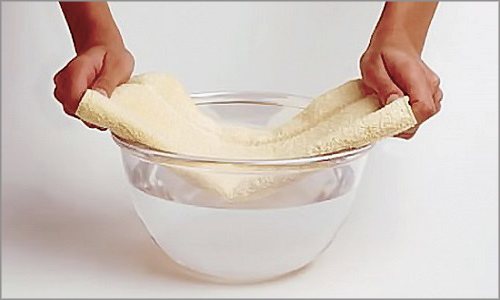
A story from the life of a patient with psoriasis
YOU CAN TOO GET RID OF PSORIASIS AND LIVE LIFE TO THE FULLEST
A year ago I managed to get rid of psoriasis. I did it without doctors, who just wanted to rip off money. On my own, at home, in just two weeks I “destroyed” chronic psoriasis, which had tormented me for years, and also significantly improved my health. I cured myself, and I’ll tell you how you too can get rid of this torment. This must be hard to believe? Of course it's difficult. I just have one secret, which I will tell you about next. This will certainly help you too.
Today I want to tell you about the new natural product PSORISIL
, which turned out to be incredibly effective. It has passed clinical trials and received quality certificates...
Find out more >>

- compresses with birch tar for 15-30 minutes;
- baths with herbs (chamomile, calendula, celandine, St. John's wort, elecampane), you need to pour 400 grams of the selected plant into 4 liters of ice water and boil, then cool the broth and make baths or lotions;
- lotions with Niftalan mud, which is sold in pharmacies and has its own method of use, which is prescribed in the instructions;
- infusions from a collection of herbs (St. John's wort, calamus, string, celandine and lingonberry leaves), you need 1 tbsp. pour a glass of boiling water over the collection, cool and take a small glass in the morning and evening;
- Apply iodine solution to the affected areas in the morning and evening; it is recommended to alternate with grease ointment (week after week).
Iodine for nail psoriasis is considered a good remedy, since it not only disinfects the affected area, but also restores the structure of the nail plate, which is also very important.
Treatment with folk remedies
The use of traditional recipes should not be used as the main method of therapy. Traditional medicine is based on the use of tinctures of well-known medicinal herbs:
- nettle;
- St. John's wort;
- aloe;
- calamus root;
- celandine;
- elecampane.
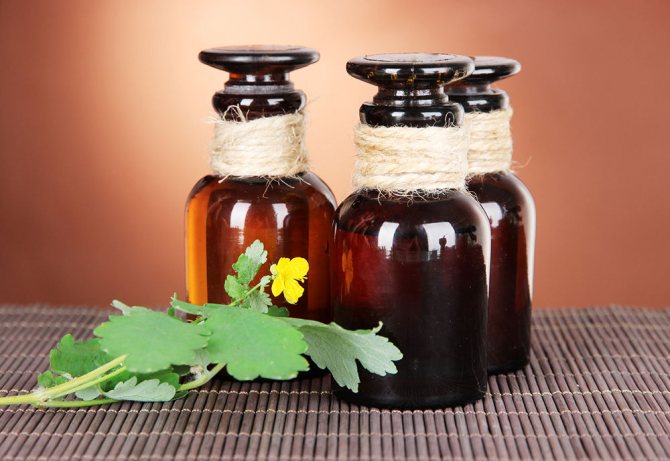
The way to use these tinctures is to take them orally or apply compresses to the affected areas. When treating nail psoriasis at home, regular use of sea salt in the form of baths shows good results. Tea tree oil is an effective antifungal agent that prevents cracking of the nail matrix and relieves inflammation of the nail bed. If there is severe itching, corn starch baths can help.
You need to understand that treatment of nail psoriasis requires a lot of patience. The duration of therapy is determined by several objective factors: slow growth of nails, active daily use of fingers, difficulties with the penetration of active substances into the affected area. If you strictly follow the dermatologist's recommendations, the overall prognosis is positive, and the duration of remission depends on many factors, including the individual characteristics of the body.
Prevention
After you have been able to cure psoriasis on your nails, you need to think about preventing relapses. To do this you just need to follow a few simple rules:
- keep your hands clean;
- do manicures only with disinfected tools and apply high-quality varnishes;
- protect skin from cold and dryness;
- eating healthy foods and avoiding harmful ones;
- treatment of all diseases until complete recovery.
Although nail psoriasis is a very unpleasant, nasty and discomforting disease, as practice shows, it is quite possible to overcome it. You just need to act in an organized manner and approach things wisely. We hope that this article was useful to you, subscribe and share the information on social networks. Be healthy!
Doctors' opinions and patient reviews
Danchenko Alexey Vadimovich (dermatologist): “Nail psoriasis is a rather complex disease, if it is not treated on time, it is fraught with serious consequences, such as frequent relapses, the unaesthetic appearance of the hands or feet, which is visible even in the photo, and Tsumbusch psoriasis , which in some cases leads to death. That is why I advise you to contact a specialist as soon as the first symptoms of the disease appear, because timely treatment is the key to success.”
Marina, 24 years old: “I would like to leave my review about nail psoriasis and my experience in this matter. My husband just recently developed small pinkish spots under his fingernails. At first they didn’t attach any importance to this, but after they began to increase, they became worried. I called my mother, and she said that this is a manifestation of psoriasis and that tar compresses help well. We did them every evening for 6 days and, fortunately, everything went away, a new healthy nail soon grew, and this infection never returned to us.”
Dmitry, 17 years old: “A month ago I noticed that the surface of my toenails had become somehow rough and very unpleasant to the touch, but I decided not to pay attention to it, after all, wherever I go, you never know where I’ve damaged it. And everything would have been fine if it weren’t for my vigilant mother, who took me to a dermatologist. The doctor said that I have the second stage of psoriasis and urgently need treatment. I saw enough photos of nail psoriasis on the Internet and, in fact, I was scared. In general, they prescribed me a special ointment and tablets, I was treated with them for about 3 weeks and soon everything went away. Now I monitor the condition of my arms and legs every day.”
This article has exclusively educational, encyclopedic and informational functions. It is necessary to obtain the approval of your physician before using the tips and recommendations described in this article. You should not self-medicate!

